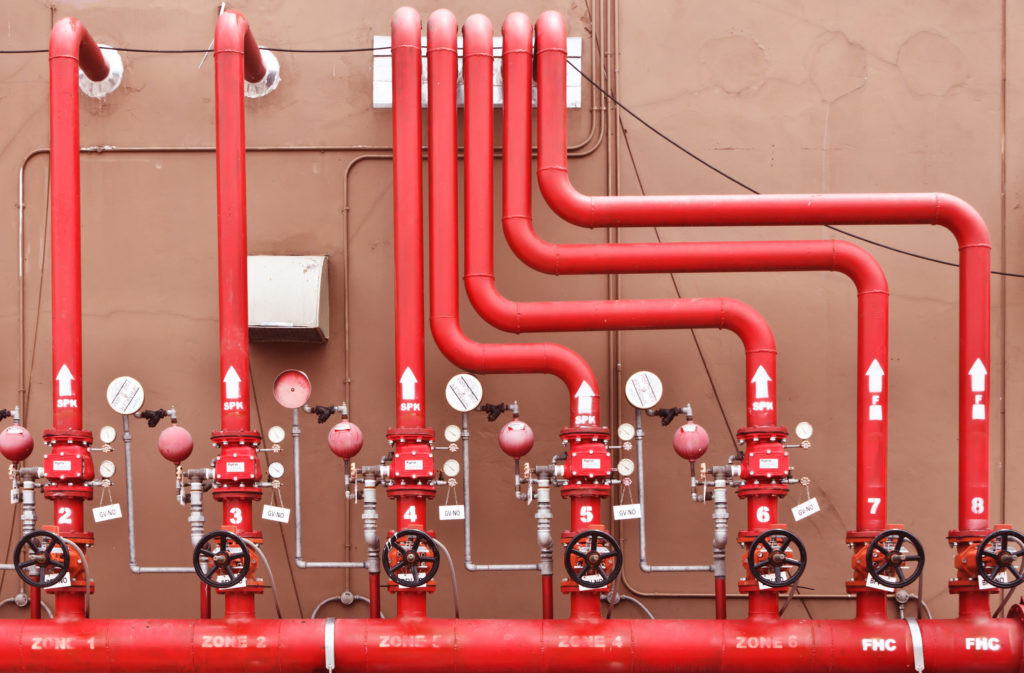Pre-action fire sprinkler systems work differently than traditional wet pipe sprinkler systems, discharging water only when a fire is detected. This eliminates the chance for accidental discharge and guarantees your facility won’t sustain unnecessary water damage.
These systems are especially beneficial in locations that house water-sensitive materials, like archival vaults and rare book libraries. Furthermore, cold storage warehouses and computer data centers can benefit from this type of system. Preaction fire suppression systems feature two separate sets of pipes: a supply line, which feeds the sprinkler heads, and a detection line, which activates the system when it senses smoke or heat. When the alarm is triggered, the system opens the supply valve and water is dispersed from the sprinkler heads.
What is a Pre-Action Sprinkler System?
A Pre-Action Sprinkler System is a hybrid dry/wet pipe sprinkler system that holds water back with an electrically operated pre-action valve. To activate this system, two distinct events must occur: detection of fire and opening of the pre-action valve to let go of water.
This two-step process helps prevent accidental discharges that could cause costly property and water damage. It also enables easy detection of leaks in the system by monitoring pressurized air or nitrogen levels.
These systems are ideal for locations with sensitive equipment or content that could be harmed due to water discharge. They’re especially beneficial in archival vaults, libraries, computer data centers and cold storage warehouses.
Click here – What Is CEL In Cars?
How does a Pre-Action Sprinkler System Work?
Businesses have a range of fire protection products to choose from. Some are straightforward one-step systems, while others feature complex mechanisms that activate only during fire emergencies.
Pre-Action Sprinkler Systems fall somewhere in the middle. They use an electronic “pre-action valve” that holds water back until activated by an independent fire detection system.
When an alarm is received from a connected smoke detector, heat detector or manual pull station, the valve opens and allows water to enter the piping system. Water will only release once temperatures reach a certain threshold.
Due to this, a pre-action system is unlikely to go off accidentally or by false alarm. It only activates when there is an actual threat of fire, reducing the risk to valuable assets and other areas in your facility.
What are the Advantages of a Pre-Action Sprinkler System?
Pre-Action Sprinkler Systems are ideal for commercial buildings with sensitive materials or places where water could potentially cause harm. Examples include museums, art galleries, storage rooms, computer data centers and other facilities that contain valuable artifacts or delicate equipment.
Contrary to wet pipe and dry pipe systems, pre-action systems do not release water until two events take place: a fire detection event such as heat or smoke detectors; and the activation of automatic fire sprinklers.
This system consists of pipes filled with compressed air or nitrogen and closed sprinkler heads. Water is held back from entering the piping by a valve until activation.
Pre-action systems come in two varieties: single interlock and double interlock. With a single interlock system, an event such as fire detection must occur prior to water entering the piping system; this usually activates either heat or smoke detectors and opens a mechanically latched valve that permits flow of liquid through it.
Click here – Match Your Home Style With Your Decorating Style
What are the Disadvantages of a Pre-Action Sprinkler System?
Pre-Action Sprinkler Systems are an innovative type of fire suppression system. They’re ideal for water-sensitive areas such as archival vaults, libraries, computer data centers and cold storage warehouses.
These locations contain a great deal of valuable material which could be damaged if water from fire sprinkler heads discharged accidentally. Therefore, they require installation of a sprinkler system with pre-action valve and fail-safes.
A Pre-Action sprinkler system has the disadvantage of being more intricate than dry pipe systems and requires a fire detection system, potentially leading to higher installation and upkeep expenses.
There is a delay before the water is released in this type of sprinkler system. However, this inconvenience is an acceptable price to pay for the increased safety that pre-action sprinklers offer your building. It’s essential to stay on top of maintenance appointments with your fire protection contractor so that your system runs optimally at all times.

